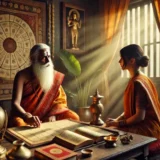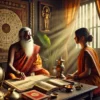Ancient Indian Mathematics & Vedic Astrology
Vedic Astrology implements mathematical calculations at every single step of prediction and analysis within its frame of reference: Whether it is finding out the solar and lunar movements, cycles or planetary observations and zodiac constellations or to calculate their impacts and results in people’s lives.

The roots of this knowledge emerged to the Indian subcontinent around 1200 BCE. Scholars have made remarkable progress like Varahamihira, Aryabhata and Bhaskara-II between 400 CE and 1200 CE, especially in Mathematics and developed its connection to Astrology. Their role played a strong foundation for many fields of study.
Ancient Indian Scholars developed Mathematics with revolutionary concepts like Zero as a number, Algebra, negative numbers, Geometry, Arithmetic, and Trigonometry. They are also behind the invention of the value of pi and reveal the modern definition of cosine and sine.
These ideas not only transformed local knowledge, but also, they spread worldwide and become the building blocks of advanced mathematics. Getting in-depth into these roots provides a combined perspective on how Mathematics progressed and what it is nowadays.
Prediction based on your Moon sign are most accurate as per Vedic Astrology. Do you know your Moon Sign? If not, find out instantly for Free by filling out the form below!
How does the contemporary world use the principles of Ancient Mathematics?
The ideologies of Ancient Mathematics continue to play a crucial role in the moder era:
Weather & Natural Phenomena: Ancient mathematical principles are used to predict the weather patterns, astronomical events and natural occurrences.
Core Study Fields: Geometry, Trigonometry, Indices, and Algebra are developed in ancient India. These are now an important part of mathematical studies across the world.
Legacy of Zero: The creation of Zero revolutionized calculations, making them more accurate. It is still a cornerstone of Modern Mathematics.
Civil Engineering: This concept, used in the modern world, have their foothold in ancient Indian Mathematics- the art and architecture of ancient India is a proof to that.
Coding & Programming: Most of the foundational mathematical ideas are essential for modern software development and programming.
Astrology: Mathematical calculations are essential tools in the Astrology practice.
The Evolution of Astrology & Mathematics in Ancient India
The Indian ancient period was marked by some valuable innovations in Mathematics and Science. Ancient Indians contributed immensely to the knowledge in Mathematics as well as various branches of science.
Baudhayan, a great Indian Mathematician was the first to discover and calculate the value of pi.
Aryabhata was a fifth century Mathematician, Astronomer, Astrologer, and Physicist. He devised a method of denoting big decimal numbers by alphabet.
Brahmagupta introduced negative numbers and operations in zero.
Bhaskara introduced Chakrawat Method or the Cyclic Method to solve algebraic equations. He contributed to Indian Astrology through his works. He authored the Siddhanta Shiromani which is divided into 4 sections: Lilavati (Arithmetic), Beejaganit (Algebra), Goladhyaya (Sphere) and Grahaganit (mathematics of planets), with the final section featuring major contributions in the field of Indian Astrology.
Varahamihira’s contribution in Jyotish or Astrology is worth mentioning. Astrology was given a very high place in ancient India, and it has continued even today. Jyotish, which means science of light, originated with the Vedas. Aryabhata and Varahamihira presented it scientifically in a systematic form.
Ancient Mathematics with Vedic Astrology: A Unique Connection
Varahamihira and Aryabhata made significant progress in both Mathematics and Astrology, which contributes to each field individually where these two are merged with creating practical applications.
Vedic Astrology implements mathematical calculations at every single step of prediction and analysis within its frame of reference: Whether it is finding out the solar and lunar movements, cycles or planetary observations and zodiac constellations or calculating their impacts and results in people’s lives, individually or a nation as a whole. All of these are based on mathematical calculations.
While Aryabhata mainly discovered and developed the field of Mathematics with a few segments on Astronomy and laid down the foundation for Astrology, it was Varahamihira who delved deeper by passionately researching the fundamentals and descriptive knowledge of what we today know as Vedic Astrology.
Some major contributions by Varahamihira:
Upon observation, some scholars believe that the ‘Meru Stambh’, the tallest building of ancient India was created for the purpose of astronomical studies and consisted of 7 stories resembling the 7 (physical) planets which are used as reference points in Vedic Astrology, and 27 windows which symbolize the 27 nakshatras or constellations, thereby laying the first foundations of Vedic Astrology.
This is used as a recorded reference even today, apart from manuscripts. The Meru Stambh became a structure built for the very purpose of astronomical and astrological studies. This indicates the importance of the subject in ancient India, its legacy & heritage in modern times, and its growth as a major field of astrological studies around the world for its accuracy and precision as compared to Western or Tropical Astrology. The Meru Stambh, today, is famously known as the Qutub Minar.
Another Contributions by Varahamihira:
Pancha Siddhantika is a great innovation of Acharya Varahamihira. This is one of the significant contributions to mathematical astronomy. This masterpiece assemblies five astronomical treatises, The Romaka Siddhanta, Surya Siddhanta, Paulisa Siddhanta, Paitama Siddhanta, and Vasishtha Siddhanta.
Pancha Siddhanta is one of the most precious and important resources for a deep understanding of the Hindu Astronomy history. Therefore, it continues to be known for its great impact on the study of ancient Indian astronomy.
As a pioneer Astrologer, he wrote on all three main branches of Astrology, covering the five main treatises of Hindu Astrology on horoscope analysis. His mathematical work included the discovery of the trigonometric formulas, which he successfully implemented in calculations for ancient Vedic Astrology.
.jpg)
2025 Horoscope Analysis
Get 2025 Vedic astrology predictions for career, finances, luck, love & marriage, family, children & health with this report.... Read More
A treatise on mathematical astronomy, Pancha Siddhantika, was invented by Varahamihira. It summarizes five earlier astronomical treatises, namely, the Surya Siddhanta, Romaka Siddhanta, Paulisa Siddhanta, Vasishtha Siddhanta and Paitama Siddhanta.
The Pancha Siddhantika of Varahamihira is one of the most important sources that invented for the Hindu Astronomy.
Conclusion
Varahamihira was a champion in the field of Ancient Astrology and Mathematics, drawing close co-relations and laying the foundations of modern-day astrology. To quote him, “The science of Astrology is a vast ocean and is not easy for everyone to cross it. My treatises provide a safe boat,” truly shows how even now his works are acknowledged as masterpieces.

Detailed Horoscope Reading
An indepth study of your birth chart will predict your future in great detail. This will not just give you peace of mind by removing the elements of uncertainty from your future, but will also help you prepare ahead of the low periods and leverage the good phases in the coming years ... Read More










